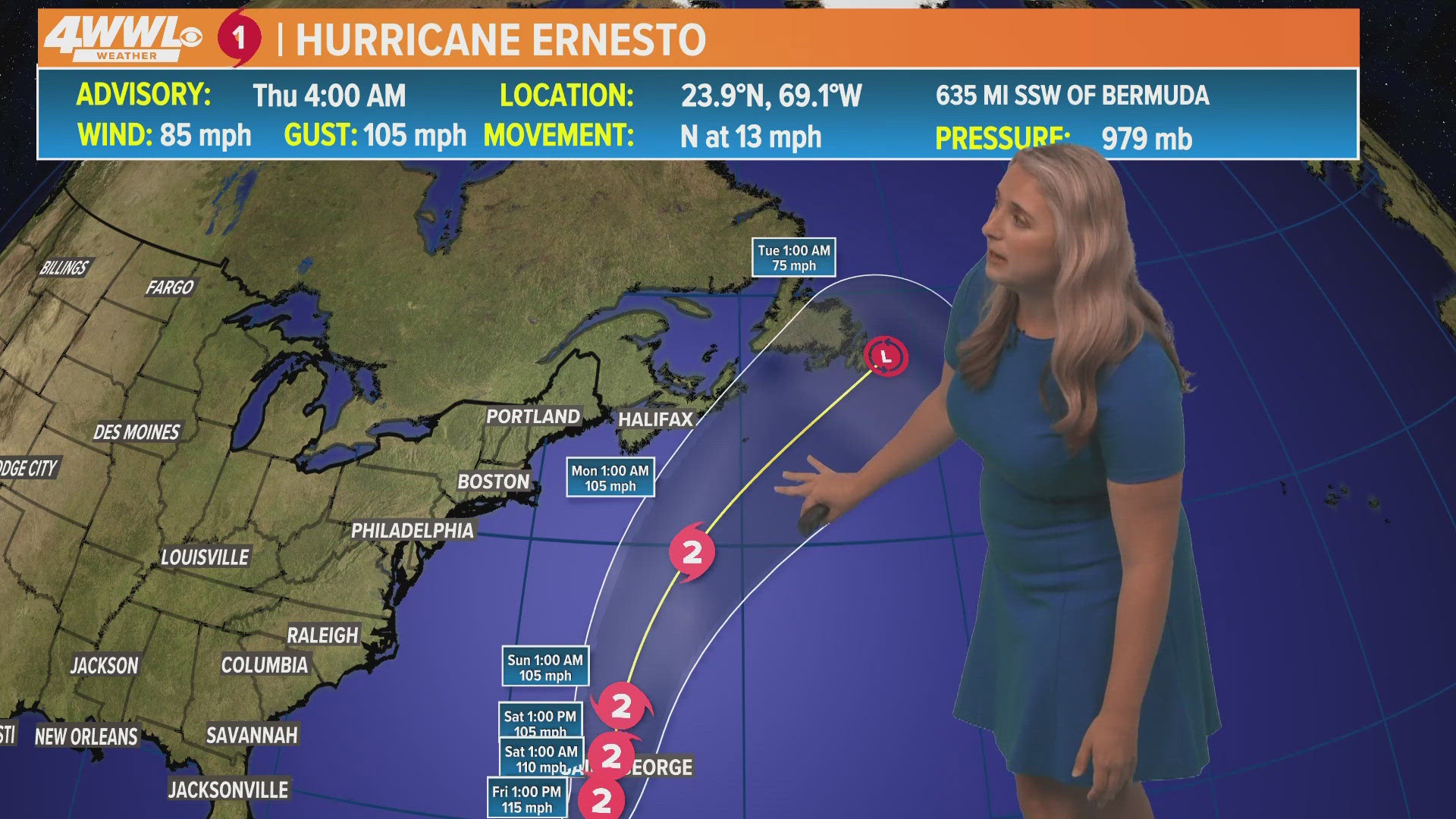TOA BAJA, Puerto Rico — Hurricane Ernesto strengthened into a Category 2 storm Thursday night as it barreled toward Bermuda after leaving hundreds of thousands of people in Puerto Rico without power or water. Sweltering heat enveloped the U.S. territory, raising concerns about people’s health.
A hurricane warning was in effect for Bermuda, with Ernesto expected to pass near or over the island Saturday.
The storm was centered about 410 miles (660 kilometers) south-southwest of Bermuda late Thursday. Its maximum sustained winds had risen to 100 mph (155 kph), and the storm was moving north-northeast at 14 mph (22 kph) over open waters.
“I cannot stress enough how important it is for every resident to use this time to prepare. We have seen in the past the devastating effects of complacency,” said National Security Minister Michael Weeks.
Ernesto was forecast to possibly reach Category 3 strength Friday and then weaken as it approaches Bermuda, where it was forecast to drop 6 to 12 inches (15 to 30 centimeters) of rain, with up to 15 inches (38 centimeters) in isolated areas.
“All of the guidance show this system as a large hurricane near Bermuda,” said the National Hurricane Center in Miami.
Ernesto was then expected to pass near or east of Atlantic Canada on Monday.
Meanwhile, the spinning storm on Thursday was generating southern winds in Puerto Rico, which have a heating effect as opposed to the typical cooling trade winds that blow from the east.
“We know a lot of people don’t have power,” said Ernesto Morales with the National Weather Service as he warned of extreme heat and urged people to stay hydrated.
More than 290,000 of 1.4 million customers remained in the dark Thursday evening, more than a day after Ernesto swiped past Puerto Rico late Tuesday as a tropical storm before strengthening into a hurricane. A maximum of 735,000 clients had been without power Wednesday.
Hundreds of thousands also were without water as many questioned the widespread power outage given that Ernesto was only a tropical storm when it spun past the island.
“I haven't slept at all,” said Ramón Mercedes Paredes, a 41-year-old construction worker who planned to sleep outdoors on Thursday night to beat the heat. “I haven't even been able to take a shower.”
At a small park in the Santurce neighborhood of the San Juan capital, Alexander Reyna, a 32-year-old construction worker, sipped on a bright red sports drink that friends provided as roosters crowed nearby above the slap of dominoes.
He had no water or power and planned to spend all day at the park as he lamented the lack of breeze, a slight film of sweat already forming on his forehead: “I have to come here because I cannot stand to be at home.”
The situation worried many who lived through Hurricane Maria, a powerful Category 4 storm that hit Puerto Rico in September 2017 and was blamed for at least 2,975 deaths in its sweltering aftermath. It also razed the island's power grid, which is still being rebuilt.
The National Weather Service issued a heat advisory on Thursday warning of “dangerously hot and humid conditions.”
Faustino Peguero, 50, said he was concerned about his wife, who has fibromyalgia, heart failure and other health conditions and needs electricity. He has a small generator at home, but he is running out of gasoline and cannot afford to buy more because he hasn't found work.
“It's chaos,” he said.
Officials said they don’t know when power will be fully restored as concerns grow about the health of many in Puerto Rico who cannot afford generators or solar panels on the island of 3.2 million people with a more than 40% poverty rate.
Crews have flown more than 540 miles (870 kilometers) across Puerto Rico and identified 400 power line failures, with 150 of them already fixed, said Juan Saca, president of Luma Energy, a private company that operates the transmission and distribution of power in Puerto Rico. The remaining failures will take more time to fix because they involve fallen trees, he added.
“We haven’t seen anything catastrophic,” he said.
When pressed for an estimate of when power would be restored, Alejandro González, Luma’s operations director, declined to say.
“It would be irresponsible to provide an exact date,” he said.
At least 250,000 customers across Puerto Rico also were without water given the power outages, down from a maximum of 350,000. Among them was 65-year-old Gisela Pérez, who was starting to sweat as she cooked sweet plantains, pork, chicken and spaghetti at a street-side diner. After her shift, she planned to buy gallons of water, since she was especially concerned about her two small dogs: Mini and Lazy.
“They cannot go without it,” she said. “They come first.”
___
Associated Press journalists Julie Walker in New York and Gabriela Aoun in San Diego contributed to this report.

